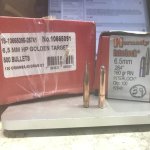I have a new 6PPC rifle coming that has a 13.5-twist Krieger barrel and Dakota Varminter action (pics below). It's not a benchrest rifle--more like a super-accurate (I hope) varmint rifle (or maybe just a range toy). In any case, I gather that 6mm bullets in the 60-gr.-68-gr. range will stabilize in this barrel, but I'd like to be able to use some varmint bullets that are slightly heavier--maybe 70-75 gr.. Does anyone here have experience with heavier 6mm bullets in slow-twist barrels, like 13.5" or 14"?




Last edited:









































































